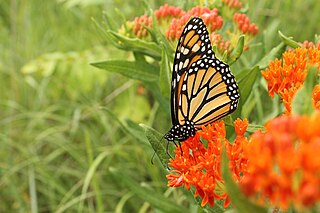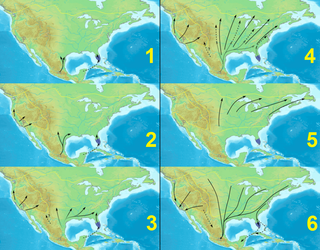
The Civilian Conservation Corps (CCC) was a voluntary government work relief program that ran from 1933 to 1942 in the United States for unemployed, unmarried men ages 18–25 and eventually expanded to ages 17–28. The CCC was a major part of President Franklin D. Roosevelt's New Deal that supplied manual labor jobs related to the conservation and development of natural resources in rural lands owned by federal, state, and local governments. The CCC was designed to supply jobs for young men and to relieve families who had difficulty finding jobs during the Great Depression in the United States. There was eventually a smaller counterpart program for unemployed women called the She-She-She Camps, which were championed by Eleanor Roosevelt.

A road verge is a strip of groundcover consisting of grass or garden plants, and sometimes also shrubs and trees, located between a roadway and a sidewalk. Verges are known by dozens of other names such as grass strip, nature strip or curb strip, the usage of which is often quite regional.

The monarch butterfly or simply monarch is a milkweed butterfly in the family Nymphalidae. Other common names, depending on region, include milkweed, common tiger, wanderer, and black-veined brown. It is among the most familiar of North American butterflies and an iconic pollinator, although it is not an especially effective pollinator of milkweeds. Its wings feature an easily recognizable black, orange, and white pattern, with a wingspan of 8.9–10.2 cm (3.5–4.0 in). A Müllerian mimic, the viceroy butterfly, is similar in color and pattern, but is markedly smaller and has an extra black stripe across each hindwing.
The National Audubon Society is an American non-profit environmental organization dedicated to conservation of birds and their habitats. Located in the United States and incorporated in 1905, Audubon is one of the oldest of such organizations in the world. There are completely independent Audubon Societies in the United States, which were founded several years earlier such as the Massachusetts Audubon Society, Indiana Audubon Society, and Connecticut Audubon Society. The societies are named for 19th century naturalist John James Audubon.
Butterfly watching is a hobby concerned with the observation and study of butterflies. It also includes the "catch and release" of butterflies. There are clubs, handbooks, checklists, and festivals devoted to the activity.

Citizen science is research conducted with participation from the general public, or amateur/nonprofessional researchers or participants for science, social science and many other disciplines. There are variations in the exact definition of citizen science, with different individuals and organizations having their own specific interpretations of what citizen science encompasses. Citizen science is used in a wide range of areas of study including ecology, biology and conservation, health and medical research, astronomy, media and communications and information science.

Brazos Bend State Park is a 4,897-acre (1,982 ha) state park along the Brazos River in unincorporated Fort Bend County, Texas, run by the Texas Parks and Wildlife Department. The park is open year-round, with the exception of several weekends a year during which it is closed for controlled hunts to manage the white-tailed deer population.

The Chicago Botanic Garden is a 385-acre (156 ha) living plant museum situated on nine islands in the Cook County Forest Preserves. It features 27 display gardens and five natural habitats including Mary Mix McDonald Woods, Barbara Brown Nature Reserve, Dixon Prairie, the Skokie River Corridor, and the Lakes and Shorelines. The garden is open every day of the year. An admission fee has been approved to start in 2022, not to exceed $35.

Butterfly gardening is a way to create, improve, and maintain habitat for lepidopterans including butterflies, skippers, and moths. Butterflies have four distinct life stages—egg, larva, chrysalis, and adult. In order to support and sustain butterfly populations, an ideal butterfly garden contains habitat for each life stage.

Cephalanthus occidentalis is a species of flowering plant in the family Rubiaceae that is native to eastern and southern North America. Common names include buttonbush, common buttonbush, button-willow, buck brush, and honey-bells.

Butterfly Conservation (BC) is a UK-wide nonprofit environmentalist organization and charity dedicated to conserving butterflies, moths, and the environment. The charity uses its research to provide advice on how to conserve and restore butterfly and moth habitats and it runs projects to protect more than 100 threatened species of Lepidoptera. Butterfly Conservation is also involved in conserving hundreds of sites and reserves for butterflies and moths throughout the UK.

The Gardeners of America/Men's Garden Clubs of America (TGOA/MGCA) is a national organization with 31 affiliated garden clubs located in 14 states (2018) across the United States. The organization is also known as Gardeners of America (TGOA) or Men’s Garden Clubs of America (MGCA). It has its headquarters in Johnston, Iowa, a business suburb of Des Moines. It is a non-profit organization incorporated in the state of Illinois, and registered with the IRS as a 501(c)(3) non-profit group. Most clubs include men and women members, and concentrate on gardening education, and community beautification and enhancement. At one time the organization had about 10,000 members.

The National Association of Black Accountants, is an American nonprofit professional association that represents the interests of more than 200,000 black professionals in furthering their educational and professional goals in accounting, finance, and related business professions. Student members are served throughout the organization's 50 chapters around the country.

Bentsen-Rio Grande Valley State Park is located at 2800 S. Bentsen Palm Drive south of the city of Mission in Hidalgo County in the U.S. state of Texas. It serves as the headquarters for the World Birding Center.

Butterfly counts are often carried out in North America and Europe to estimate the populations of butterflies in a specific geographical area.

Monarch butterfly migration is the phenomenon, mainly across North America, where the subspecies Danaus plexippus plexippus migrates each summer and autumn to and from overwintering sites on the West Coast of California or mountainous sites in Central Mexico. Other subspecies perform minor migrations or none at all. This massive movement of butterflies has been called "one of the most spectacular natural phenomena in the world".
Jeffrey Glassberg is an American biologist and author. Following a distinguished academic career he pioneered and patented work in DNA Fingerprinting. Later he founded the North American Butterfly Association (NABA) and is the leading proponent of moving interest in butterflies from hobbyist collecting and nets to butterflying with binoculars and cameras. He has written a number of field guides as well as numerous articles.

Churchville Nature Center is a facility of the Bucks County, Pennsylvania Department of Parks and Recreation and is located in Churchville, Pennsylvania. The center focuses on environmental education, public outreach and the preservation of native wildlife through its wide range of programs, projects and surveys. The nature center offers educational programing year round through its Environmental Education and Lenape Village departments. The center features a native butterfly house and covers 55 acres of wildlife preserve.














